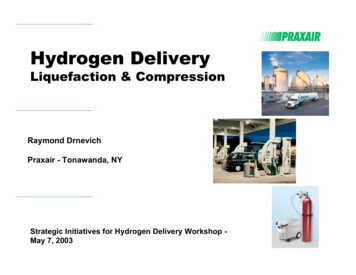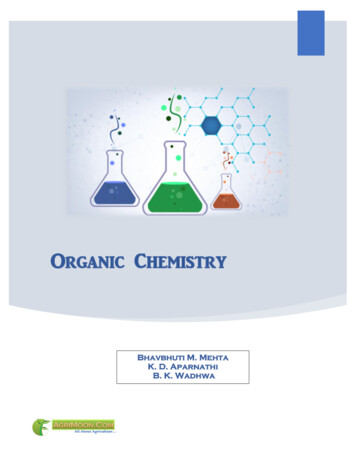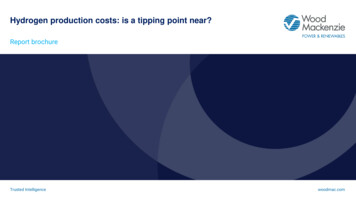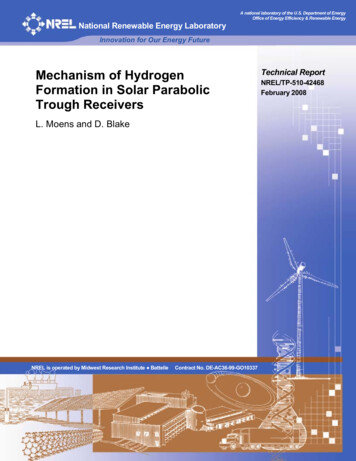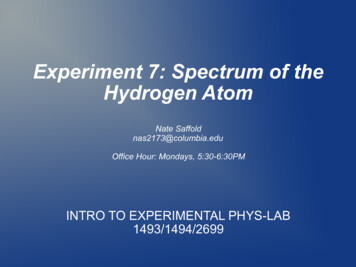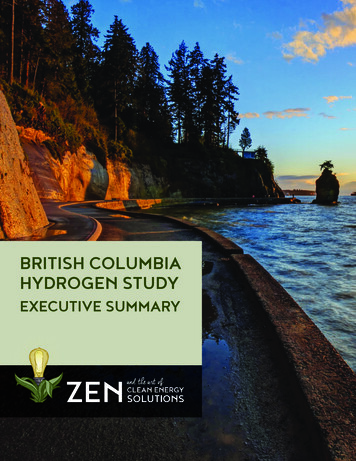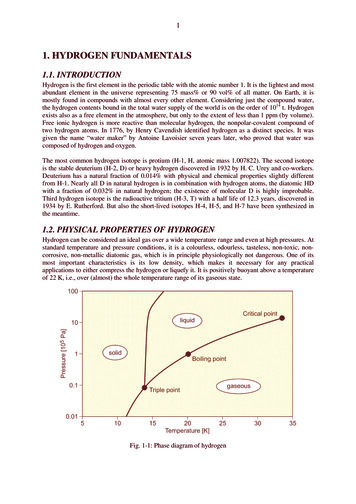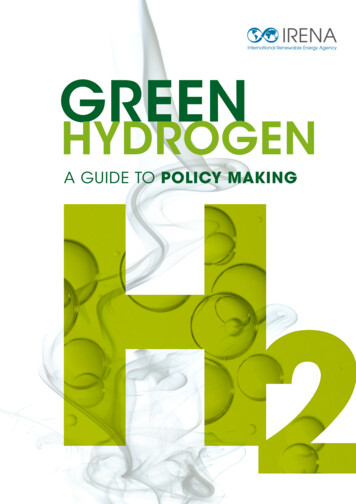
Transcription
GREENHYDROGENA GUIDE TO POLICY MAKING
IRENA 2020Unless otherwise stated, material in this publication may be freely used, shared, copied, reproduced,printed and/or stored, provided that appropriate acknowledgement is given of IRENA as the source andcopyright holder. Material in this publication that is attributed to third parties may be subject to separateterms of use and restrictions, and appropriate permissions from these third parties may need to be securedbefore any use of such material.Citation: IRENA (2020), Green Hydrogen: A guide to policy making,International Renewable Energy Agency, Abu DhabiISBN: 978-92-9260-286-4ABOUT IRENAThe International Renewable Energy Agency (IRENA) serves as the principal platformfor international co-operation, a centre of excellence, a repository of policy, technology,resource and financial knowledge, and a driver of action on the ground to advancethe transformation of the global energy system. An intergovernmental organisationestablished in 2011, IRENA promotes the widespread adoption and sustainable use ofall forms of renewable energy, including bioenergy, geothermal, hydropower, ocean,solar and wind energy, in the pursuit of sustainable development, energy access, energysecurity and low-carbon economic growth and prosperity.www.irena.orgACKNOWLEDGEMENTSThe report benefited from the reviews and comments of experts, including Cédric Philibert(independent consultant), Matthias Deutsch (Agora Energiewende), Frank Wouters (EU-GCCClean Energy Technology Network), Ruud Kempener (European Commission – DG Energy),Antonello di Pardo (GSE S.p.A.), Jose Miguel Bermudez and Peerapat Vithayasrichareon(IEA), Pierpaolo Cazzola and Matteo Craglia (ITF), Karl Hauptmeier (Norsk e-Fuel), MassimoSantarelli (Polytechnic University of Turin), Duncan Gibb (REN21), Thierry Lepercq (Soladvent),Hergen Thore Wolf (Sunfire GmbH), Kirsten Westphal (SWP), Ad van Wijk (TU Delft),Rina Bohle Zeller and Andrew Gordon Syme Mcintosh (Vestas).IRENA colleagues Dolf Gielen, Diala Hawila, Emanuele Taibi, Paul Durrant, Raul Miranda,Barbara Jinks, Nicholas Wagner, Sufyan Diab, Jinlei Feng and Abdullah Abou Ali alsoprovided valuable input.The report was authored by Emanuele Bianco and Herib Blanco under the guidance ofRabia Ferroukhi.Available for download: www.irena.org/publicationsFor further information or to provide feedback: publications@irena.orgDISCLAIMERThis publication and the material herein are provided “as is”. All reasonable precautions have been takenby IRENA to verify the reliability of the material in this publication. However, neither IRENA nor any ofits officials, agents, data or other third-party content providers provides a warranty of any kind, eitherexpressed or implied, and they accept no responsibility or liability for any consequence of use of thepublication or material herein.The information contained herein does not necessarily represent the views of all Members of IRENA. Themention of specific companies or certain projects or products does not imply that they are endorsedor recommended by IRENA in preference to others of a similar nature that are not mentioned. Thedesignations employed, and the presentation of material herein, do not imply the expression of anyopinion on the part of IRENA concerning the legal status of any region, country, territory, city or area orof its authorities, or concerning the delimitation of frontiers or boundaries.2
CONTENTINTRODUCTION. . . . . . . . . . . . . . . . . . . . . . . . . . . . . . . . . . . . . . . . . . . . . . . . . . . . . . . . . . . . . . . . . . 04ABOUT THIS GUIDE. . . . . . . . . . . . . . . . . . . . . . . . . . . . . . . . . . . . . . . . . . . . . . . . . . . . . . . . . . . . . . . 051. GREEN HYDROGEN: STATUS, DRIVERS AND BARRIERS. . . . . . . . .061.1. Different shades of hydrogen. . . . . . . . . . . . . . . . . . . . . . . . . . . . . . . . . . . . . . . . . . . . 081.2. Drivers of the new wave of green hydrogen.1.3. Barriers to the uptake of green hydrogen. . . . . . . . . . . . . . . . . . . . . . . . . . . . . . . 10. . . . . . . . . . . . . . . . . . . . . . . . . . . . . . . . .131.4. Policies to support green hydrogen. . . . . . . . . . . . . . . . . . . . . . . . . . . . . . . . . . . . . . . 162. PILLARS FOR GREEN HYDROGEN POLICY MAKING. . . . . . . . . . . . . .182.1. Policy pillar 1: National strategies. . . . . . . . . . . . . . . . . . . . . . . . . . . . . . . . . . . . . . . . . 192.2. Policy pillar 2: Establish policy priorities for green hydrogen. . . . . . . . . . . . . . . . . 262.3. Policy pillar 3: Guarantee of origin scheme . . . . . . . . . . . . . . . . . . . . . . . . . . . . . . . . 292.4. Policy pillar 4: Governance system and enabling policies. . . . . . . . . . . . . . . . . . . . 313. SUPPORTING POLICIES FOR GREEN HYDROGEN. . . . . . . . . . . . . . . .343.1. Policy support for electrolysis . . . . . . . . . . . . . . . . . . . . . . . . . . . . . . . . . . . . . . . . . . . 363.2. Policy support for hydrogen infrastructure . . . . . . . . . . . . . . . . . . . . . . . . . . . . . . . . 383.3. Policy support for hydrogen in industrial applications. . . . . . . . . . . . . . . . . . . . . . . 403.4. Policy support for synthetic fuels in aviation. . . . . . . . . . . . . . . . . . . . . . . . . . . . . . . 423.5. Policy support for hydrogen use in maritime shipping. . . . . . . . . . . . . . . . . . . . . . . 444. CONCLUSIONS. . . . . . . . . . . . . . . . . . . . . . . . . . . . . . . . . . . . . . . . . . . . . . . . . . . . . . . .46References . . . . . . . . . . . . . . . . . . . . . . . . . . . . . . . . . . . . . . . . . . . . . . . . . . . . . . . . . . . . . . . . . . . . . . 48Photograpghs. . . . . . . . . . . . . . . . . . . . . . . . . . . . . . . . . . . . . . . . . . . . . . . . . . . . . . . . . . . . . . . . . . . . 50Abbreviations and units of measure. . . . . . . . . . . . . . . . . . . . . . . . . . . . . . . . . . . . . . . . . . . . . . . . . 51FIGURESFigure 1.1 Green hydrogen production, conversion and end usesacross the energy system. . . . . . . . . . . . . . . . . . . . . . . . . . . . . . . . . . . . . . . . . . . . . . 07Figure 1.2 Selected shades of hydrogen. . . . . . . . . . . . . . . . . . . . . . . . . . . . . . . . . . . . . . . . . 08TA B L E SFigure 1.3 Hydrogen production cost depending on electrolysersystem cost, electricity price and operating hours. . . . . . . . . . 14Table 2.1 Examples of guaranteeof origin schemes. . . . . . . . . . . . . . . . . . . 29Figure 1.4 Number of hydrogen policies at a global levelby segment of the value chain. . . . . . . . . . . . . . . . . . . . . . . . . . . . . . . . . . . . . . . . 16Figure 2.1 Steps leading to the formulation of a national strategy. . . . . . 20Figure 2.2 Government hydrogen-related initiatives announcedbetween June 2018 and November 2020. . . . . . . . . . . . . . . . . . . . . . . 22Figure 2.3 Main aspects and instruments mentioned in the EUhydrogen strategy. . . . . . . . . . . . . . . . . . . . . . . . . . . . . . . . . . . . . . . . . . . . . . . . . . . . . . . . . 25Figure 2.4 Hydrogen as a complement to alternative ways todecarbonise end uses. . . . . . . . . . . . . . . . . . . . . . . . . . . . . . . . . . . . . . . . . . . . . . . . . . . . 27Figure 2.5 Guarantees of origin lifecycle emissions (Illustrative). . . . . . . 30Figure 3.1 Selected barriers and policies for segments of thehydrogen value chain. . . . . . . . . . . . . . . . . . . . . . . . . . . . . . . . . . . . . . . . . . . . . . . . . . . . 35B OX E SBox 1.1 Roles for green hydrogenin different energytransition scenarios. . . . . . . . . . . . . . . . . 12Box 1.2 Key cost componentsfor green hydrogen . . . . . . . . . . . . . . . . 14Box 1.3 Hydrogen emissions fromgrid-powered electrolysis. . . . . . . 15Box 2.1The EU hydrogen strategy. . . . . 243
INTRODUCTIONThe world is facing the major challenge of climatechange. In 2015 the global community committed totaking action to keep global temperature rise this centurywell below 2 C above pre-industrial levels. A growingnumber of countries are pledging to reach net-zero carbondioxide (CO 2) emissions by mid-century with the goal oflimiting temperature rise to 1.5 C. Achieving the deep or fulldecarbonisation of economies will require concerted andwide-ranging action across all economic sectors.We have barely begun such emission reductions. It hasbeen estimated that 8.8% less CO 2 was emitted in the firstsix months of 2020 than in the same period in 2019, followingthe COVID-19 pandemic and the consequent lockdowns(Liu et al., 2020). But for continued long-term reduction,the need for structural and transformational changes inour global energy production, consumption and underlyingsocio-economic systems cannot be understated.Dramatic emission reductions are both technologicallyfeasible and economically affordable. IRENA’s GlobalRenewables Outlook report offers a perspective forreaching net-zero emissions in the 2050-2060 timeframe.The Deeper Decarbonisation Perspective suggestspossibilities for accelerated action to bring down CO 2emissions while bringing an economic payback of betweenUSD 1.5 and USD 5 for every USD 1 spent on the energytransition (IRENA, 2020a).The energy transformation requires a major shift inelectricity generation from fossil fuels to renewablesources like solar and wind, greater energy efficiencyand the widespread electrification of energy usesfrom cars to heating and cooling in buildings. Still, notall sectors or industries can easily make the switch fromfossil fuels to electricity. Hard-to-electrify (and thereforehard-to-abate) sectors include steel, cement, chemicals,long-haul road transport, maritime shipping and aviation(IRENA, 2020b).Green hydrogen an provide a link between growing andsustainable renewable electricity generation and thehard-to-electrify sectors (IRENA, 2018). Hydrogen ingeneral is a suitable energy carrier for applications remotefrom electricity grids or that require a high energy density,and it can serve as a feedstock for chemical reactions toproduce a range of synthetic fuels and feedstocks.Additional benefits of green hydrogen include: the potentialfor additional system flexibility and storage, which supportfurther deployment of variable renewable energy (VRE);contribution to energy security; reduced air pollution; andother socio-economic benefits such as economic growthand job creation, and industrial competitiveness.Nevertheless, green hydrogen will have to overcomeseveral barriers to fulfil its full potential. Chief among thosebarriers is cost.Overcoming the barriers and transitioning green hydrogenfrom a niche player to a widespread energy carrier willrequire dedicated policy in each of the stages of technologyreadiness, market penetration and market growth. Anintegrated policy approach is needed to overcomethe initial resistance and reach a minimum thresholdfor market penetration, resting on four central pillars:building national hydrogen strategies, identifying policypriorities, establishing a governance system and enablingpolicies, and creating a system for guarantee of origin forgreen hydrogen.4
ABOUT THIS GUIDEThis publication is the first of a series of briefs that aim toguide policy makers in the design and implementation ofpolicy to support green hydrogen as one of the feasiblemethods of decarbonising the energy sector.maritime shipping). Selected policy recommendations forthese uses are presented here in the third chapter. Futurebriefs will explore niche applications for hydrogen, such aspower generation and heating, and land transport.This guide is composed of three chapters. The first focuseson the status and drivers of green hydrogen and the barriersit faces. The second chapter explores the pillars of nationalpolicy making to support hydrogen, and the third presentsthe main policy recommendations in different segments ofthe green hydrogen value chain.Each of the policy briefs will present relevant case studies tohighlight previous experiences and provide potential startingpoints for governments, exploring policies to supportgreater use of green hydrogen. They will also offer policyrecommendations, which can be adapted and tailored forspecific countries depending on their context and prioritiesbeyond the energy system, such as economic developmentobjectives.The forthcoming brief is due to be published and will addressthe supply side, covering electrolysis and infrastructure. Thefollowing briefs will first explore specific policies for differentuses of green hydrogen in the hard-to-abate sectors, includingindustrial applications and long-haul transport (aviation,Some of the necessary policy tools already exist in energysector and only need to be expanded in scope. However, inother cases dedicated attention might be needed.I R E N A’S WO R K O N G R E E N H Y D R O G E NA N D H A R D TO A BAT E S ECTO R S.This report is part of IRENA’s ongoing programme of workto provide its members countries and the wider communitywith expert analytical insights into the potential options,enabling conditions and policies that could deliver the deepdecarbonisation of economies.Recent and upcoming publications include:IRENA’s annual Global Renewable Outlook provides detailedglobal and regional roadmaps for emission reductionsalongside assessment of the socioeconomic implications. The2020 edition includes Deep Decarbonisation Perspectivesdetailing options for achieving net-zero or zero emissions. “Green hydrogen cost reduction: Scaling up electrolysersto meet the 1.5 C climate goal” (forthcoming);The 2021 edition will include further detailed analysis of apathway consistent with a 1.5-degree goal.Building on its technical and socio-economic assessmentIRENA is analysing specific facets of that pathway includingthe policy and financial frameworks needed. One particularfocus is on the potential of green hydrogen. “Hydrogen: A renewable energy perspective” (2019); “Reaching zero with renewables” (2020) and its supportingbriefs on industry and transport; “Renewable energy policies in a time of transition: Heatingand cooling” (forthcoming) and the subsequent briefs to this report.These reports complement IRENA’s work on renewablesbased electrification, biofuels and synthetic fuels and all theoptions for specific hard-to-abate sectorsThis analytical work is supported by IRENA’s initiativesto convene experts and stakeholders, including IRENAInnovation Weeks, IRENA Policy Days and Policy Talks, andthe IRENA Collaborative Platform on Green Hydrogen. Thesebring together a broad range of member countries and otherstakeholders to exchange knowledge and experience.5
1GREEN HYDROGEN:STATUS, DRIVERSAND BARRIERS001HHydrogenThe firstindustrial waterelectrolyser wasdeveloped in1888HenryCavendishdiscoveredthe element in17661.01Hydrogen means“Creator (-gen) of water (hydro-)”:its combustion releases only waterH2OH2OGreen hydrogen is an energy carrier thatcan be used in many different applications(Figure 1.1). However, its actual use is still verylimited. Each year around 120 million tonnesof hydrogen are produced globally, of whichtwo-thirds are pure hydrogen and one-thirdis in a mixture with other gases (IRENA,2019a). Hydrogen output is mostly usedfor crude oil refining and for ammonia andmethanol synthesis, which together representalmost 75% of the combined pure and mixedhydrogen demand.6Most abundantchemicalstructure inthe universeToday’s hydrogen production is mostly basedon natural gas and coal, which togetheraccount for 95% of production. Electrolysisproduces around 5% of global hydrogen,as a by-product from chlorine production.Currently, there is no significant hydrogenproduction from renewable sources: greenhydrogen has been limited to demonstrationprojects (IRENA, 2019a).
G R E E N H Y D R O G E N : STAT U S , D R I V E R S A N D B A R R I E R SFIGURE 1.1 Green hydrogen production, conversion and end uses across the energy ESSINGEND USE2INDUSTRYSteel industryRenewableenergyChemical industryRefineriesNO hippingAviationTrucksTRANSFORMATIONSustainable CO2CO2 ource: IRENA.* The term synthetic fuels refers here to a range of hydrogen-based fuels produced through chemical processes with a carbon source(CO and CO2 captured from emission streams, biogenic sources or directly from the air). They include methanol, jet fuels, methane andother hydrocarbons. The main advantage of these fuels is that they can be used to replace their fossil fuel-based counterparts and inmany cases be used as direct replacements – that is, as drop-in fuels. Synthetic fuels produce carbon emissions when combusted, but iftheir production process consumes the same amount of CO2, in principle it allows them to have net-zero carbon emissions.7
CHAPTER ONE1.1. DIFFERENT SHADES OF HYDROGENHydrogen can be produced with multipleprocesses and energy sources; a colour codenomenclature is becoming commonly usedto facilitate discussion (Figure 1.2). But policymakers should design policy using an objectivemeasure of impact based on life-cyclegreenhouse gas (GHG) emissions, especiallysince there might be cases that do not fullyfall under one colour (e.g. mixed hydrogensources, electrolysis with grid electricity) (seeSection 2.3).FIGURE 1.2 Selected shades of hydrogenColorGREYHYDROGENProcessSMR or gasificationMethane or GENSMR or gasificationwith carbon capture(85-95%)PyrolysisElectrolysisMethane or coalMethaneRenewableelectricityNote: SMR steam methane reforming.* Turquoise hydrogen is an emerging decarbonisation option.8
GREYDROGENBLUEDROGENQUOISEROGENG R E E N H Y D R O G E N : STAT U S , D R I V E R S A N D B A R R I E R SGREY HYDROGEN1 is produced with fossil fuels (i.e. hydrogen produced from methane usingsteam methane reforming (SMR) or coal gasification). The use of grey hydrogen entails substantialCO 2 emissions, which makes these hydrogen technologies unsuitable for a route toward OGENBLUEHYDROGENBLUEDuringearly stages TURQUOISEof the energy transition,GREENthe use of BLUE HYDROGEN (i.e. grey hydrogen with carbonHYDROGENHYDROGENHYDROGENcapture and storage [CCS]) could facilitate the growth of a hydrogen market. Around three-quarters ofhydrogen is currently produced from natural gas. Retrofitting with CCS would allow the continued use ofexisting assets while still achieving lower GHG emissions. This is an option is to produce hydrogen with lowerGHG emissions while reducing pressure on the renewable energy capacity installation rate to produce greenhydrogen. Notably, industrial processes like steel production may require a continuous flow of hydrogen;blue hydrogen could be an initial solution while green hydrogen ramps up production and storage capacityto meet the continuousGREENflow requirement.TURQUOISEHYDROGENHYDROGENHowever, blue hydrogen has limitations that have so far restricted its deployment: it uses finiteresources, is exposed to fossil fuel price fluctuations, and does not support the goals of energy security.Moreover, blue hydrogen faces social acceptance issues, as it is associated with additional costs for CO2transport and storage and requires monitoring of stored CO2 . In addition, CCS capture efficiencies areexpected to reach 85-95% at best,2 which means that 5-15% of the CO2 will still be emitted. And thesehigh capture rates have yet to be achieved.In sum, the carbon emissions from hydrogen generation could be reduced by CCS but not eliminated.Moreover, these processes use methane, which brings leakages upstream, and methane is a much morepotent GHG per molecule than CO2. This means that while blue hydrogen could reduce CO2 emissions, itdoes not meet the requirements of a net-zero future. For these reasons, blue hydrogen should be seenonly as a short-term transition to facilitate the uptake of green hydrogen on the path to net-zero YDROGENGREENHYDROGENTURQUOISE HYDROGEN combines the use of natural gas as feedstock with no CO2 production.Through the process of pyrolysis, the carbon in the methane becomes solid carbon black. A market forcarbon black already exists, which provides an additional revenue stream. Carbon black can be moreeasily stored than gaseous CO2 . At the moment, turquoise hydrogen is still at the pilot stage. (Philibert,2020; Monolith, 2020).GREENAmong the different shades of hydrogen, GREEN HYDROGEN – meaning hydrogen produced fromHYDROGENrenewable energy – is the most suitable one for a fully sustainable energy transition. The mostestablished technology options for producing green hydrogen is water electrolysis fuelled byrenewable electricity. This technology is the focus of this report. Other renewables-based solutions toproduce hydrogen exist. 3 However, except for SMR with biogases, these are not mature technologiesat commercial scale yet (IRENA, 2018). Green hydrogen production through electrolysis is consistentwith the net-zero route, allows the exploitation of synergies from sector coupling, thus decreasingtechnology costs and providing flexibility to the power system. Low VRE costs and technologicalimprovement are decreasing the cost of production of green hydrogen. For these reasons, greenhydrogen from water electrolysis has been gaining increased interest.1 Sometimes referred to as black or brown hydrogen.2 An alternative route to SMR could be a process called autothermal reforming, for which it is estimated that a possible capture rate up to 94.5% of the CO2emitted is possible (H-Vision, 2019).3 For example, biomass gasification and pyrolysis, thermochemical water splitting, photocatalysis, supercritical water gasification of biomass, combined darkfermentation and anaerobic digestion.9
CHAPTER ONE1.2. D RIVERS OF THE NEW WAVEOF GREEN HYDROGENThere have been several waves of interestin hydrogen in the past. These were mostlydriven by oil price shocks, concerns aboutpeak oil demand or air pollution, and researchon alternative fuels. Hydrogen can contributeto energy security by providing anotherenergy carrier with different supply chains,producers and markets; this can diversifythe energy mix and improve the resilienceof the system. Hydrogen can also reduceair pollution when used in fuel cells, with noemissions other than water. It can promoteeconomic growth and job creation given thelarge investment needed to develop it as anenergy carrier from an industrial feedstock.As a result, more and more energy scenariosare giving green hydrogen a prominent role,albeit with significantly different volumes ofpenetration (see Box 1.1). The new wave ofinterest is focused on delivering low-carbonsolutions and additional benefits that onlygreen hydrogen can provide. The drivers forgreen hydrogen include:1.Low variable renewable energy(VRE) electricity costs. The majorcost driver for green hydrogen isthe cost of electricity. The price of electricityprocured from solar PV and onshore wind plantshas decreased substantially in the last decade.In 2018, solar energy was contracted at a globalaverage price of 56 USD/MWh, compared with250 in 2018. Onshore wind prices also fell duringthat period, from 75 USD/MWh in 2010 to 48 in2018 (IRENA, 2019b). New record-low prices weremarked in 2019 and 2020 around the world: solarPV was contracted at USD 13.12/MWh in Portugal(Morais, 2020) and USD 13.5/MWh in the UnitedArab Emirates (Abu Dhabi) (Shumkov, 2020);onshore wind was contracted at USD 21.3/MWhin Saudi Arabia (Masdar, 2019) while in Brazil,prices ranged between USD 20.5 and 21.5/MWh(BNEF, 2019). With the continuously decreasingcosts of solar photovoltaic and wind electricity,the production of green hydrogen is increasinglyeconomically attractive.2.Technologies ready to scaleup. Many of the components inthe hydrogen value chain havealready been deployed on a small scaleand are ready for commercialisation, nowrequiring investment to scale up. The capitalcost of electrolysis has fallen by 60% since2010 (Hydrogen Council, 2020), resulting ina decrease of hydrogen cost from a range ofUSD 10-15/kg to as low as USD 4-6/kg in thatperiod. Many strategies exist to bring downcosts further and support a wider adoptionof hydrogen (IRENA, forthcoming). The costof fuel cells4 for vehicles has decreased by atleast 70% since 2006 (US DOE, 2017).4 Fuel cells use the same principles as an electrolyser, but in the opposite direction, for converting hydrogen and oxygeninto water in a process that produces electricity. Fuel cells can be used for stationary applications (e.g. centralised powergeneration) or distributed applications (e.g. fuel cell electric vehicles). Fuel cells can also convert other reactants, such ashydrocarbons, ethers or alcohols.10
G R E E N H Y D R O G E N : STAT U S , D R I V E R S A N D B A R R I E R SWhile some technologies have not been demonstratedat scale yet (such as ammonia-fuelled ships) (IRENA,2020b), scaling up green hydrogen could makethose pathways more attractive as productioncosts decrease.3. enefits for the power system. As the shareBof VRE rapidly increases in various marketsaround the world, the power system will needmore flexibility. The electrolysers used to produce greenhydrogen can be designed as flexible resources that canquickly ramp up or down to compensate for fluctuations inVRE production, by reacting to electricity prices (Eichman,Harrison and Peters, 2014). Green hydrogen can be storedfor long periods, and can be used in periods when VRE is notavailable for power generation with stationary fuel cells orhydrogen-ready gas turbines. Flexible resources can reduceVRE curtailment, stabilise wholesale market prices andreduce the hours with zero or below zero electricity prices (ornegative price), which increases the investment recovery forrenewable generators and facilitates their expansion. Finally,hydrogen is suitable for long-term, seasonal energy storage,complementing pumped-storage hydropower plants. Greenhydrogen thus supports the integration of higher shares ofVRE into the grid, increasing system efficiency and costeffectiveness.4.Government objectives for net-zero energysystems. By mid-2020, seven countries hadalready adopted net-zero GHG emission targetsin legislation, and 15 others had proposed similar legislationor policy documents. In total, more than 120 countries haveannounced net-zero emissions goals (WEF, 2020). Amongthem is the People’s Republic of China (hereafter “China”),the largest GHG emitter, which recently pledged to cut itsnet carbon emissions to zero within 40 years. While thesenet-zero commitments have still to be transformed intopractical actions, they will require cutting emissions in the“hard-to-abate” sectors where green hydrogen can play animportant role.5.Broader use of hydrogen. Previous waves ofinterest in hydrogen were focused mainly onexpanding its use in fuel cell electric vehicles(FCEVs). In contrast, the new interest covers many possiblegreen hydrogen uses across the entire economy, includingthe additional conversion of hydrogen to other energycarriers and products, such as ammonia, methanol andsynthetic liquids. These uses can increase the future demandfor hydrogen and can take advantage of possible synergiesto decrease costs in the green hydrogen value chain. Greenhydrogen can, in fact, improve industrial competitiveness, notonly for the countries that establish technology leadershipin its deployment, but also by providing an opportunity forexisting industries to have a role in a low-carbon future.Countries with large renewable resources could derive majoreconomic benefits by becoming net exporters of greenhydrogen in a global green hydrogen economy.6.I nterest of multiple stakeholders. As a result ofall the above points, interest in hydrogen is nowwidespread in both public and private institutions.These include energy utilities, steel makers, chemicalcompanies, port authorities, car and aircraft manufacturers,shipowners and airlines, multiple jurisdictions and countriesaiming to use their renewable resources for export orto use hydrogen to improve their own energy security.These many players have also created partnerships andongoing initiatives to foster collaboration and co ordinationof efforts.6However, green hydrogen still faces barriers.5 System flexibility is here defined as the ability of the power system to match generation and demand at any timescale.6 The Hydrogen Council is an example of a private initiative. Launched in 2017, it has 92 member companies (by October 2020). The Hydrogen Initiative under theClean Energy Ministerial is an example of a public initiative, where nine countries and the European Union are collaborating to advance hydrogen. The Fuel Celland Hydrogen Joint Undertaking is an example of private-public partnership in the European Union.11
CHAPTER ONEBox 1.1 Roles for green hydrogen in different energy transitionscenariosThe role given to green hydrogen in existing regional and global energy transition scenariosdiffers greatly due to a number of factors.First, not all scenarios aim for the same GHG reduction target. The more ambitious the GHGreduction target, the greater is the amount of green hydrogen expected in the system. Forlow levels of decarbonisation, renewable power and electrification might be enough. Butwith deeper decarbonisation targets, green hydrogen would play a larger role in the futureenergy mix.Second, not all scenarios rely on the same set of enabling policies. The removal of fossil fuelsubsidies, for example, would increase the space for carbon-free solutions.Third, the technology options available vary between scenarios. Scenarios that
Figure 1.2 Selected shades of hydrogen. 08 Figure 1.3 Table 2.1Hydrogen production cost depending on electrolyser system cost, electricity price and operating hours. 14 Figure 1.4 Number of hydrogen policies at a global level
